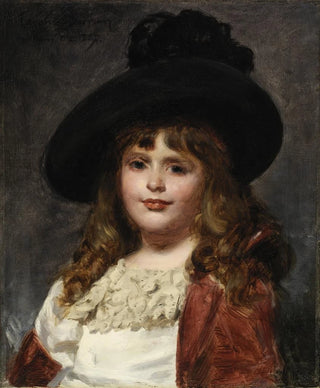Painting Laura at seven years old - Carolus-Duran | Art print


View from behind

Frame (optional)
In the fascinating universe of painting, some artworks manage to transcend time and capture the very essence of childhood. "Laura at seven years old" by Carolus-Duran is one of these timeless creations, where each brushstroke seems to whisper secrets of innocence and curiosity. This canvas, created at the end of the 19th century, offers an intimate glimpse into the life of a young girl, Laura, whose delicate and dreamy expression invites us to explore the depths of her imagination. Contemplating this piece, the viewer is transported to a world where the lightness of childhood blends with the promises of a radiant future. The magic of this painting lies in its ability to evoke deep emotions through the simplicity of a moment frozen in time.
Style and uniqueness of the work
Carolus-Duran's style is distinguished by its realistic approach and technical mastery. In "Laura at seven years old," the artist manages to capture the light in a way that brings his subject to life. The delicate nuances of the child's skin, the subtle reflections in her hair, and the texture of her dress fabrics create an atmosphere of softness and tenderness. Duran uses pastel colors that, far from being loud, evoke a rare harmony and serenity. The composition of the canvas, centered on Laura's face, immediately draws the eye and allows her to become the focal point of the work. This staging choice, combined with impressive painting techniques, gives the canvas an almost photographic dimension, while maintaining an aura of dreaminess. The artist thus succeeds in immortalizing not only a face but also the innocence and purity of a bygone era.
The artist and his influence
Carolus-Duran, whose real name is Charles Émile Auguste Durand, is a master of 19th-century French painting, recognized for his talent in capturing the psychology of his subjects. Trained at the Académie des Beaux-Arts, he stands out for his innovative approach that blends realism with impressionist sensitivity. Duran had the opportunity to associate with great

Matte finish

View from behind

Frame (optional)
In the fascinating universe of painting, some artworks manage to transcend time and capture the very essence of childhood. "Laura at seven years old" by Carolus-Duran is one of these timeless creations, where each brushstroke seems to whisper secrets of innocence and curiosity. This canvas, created at the end of the 19th century, offers an intimate glimpse into the life of a young girl, Laura, whose delicate and dreamy expression invites us to explore the depths of her imagination. Contemplating this piece, the viewer is transported to a world where the lightness of childhood blends with the promises of a radiant future. The magic of this painting lies in its ability to evoke deep emotions through the simplicity of a moment frozen in time.
Style and uniqueness of the work
Carolus-Duran's style is distinguished by its realistic approach and technical mastery. In "Laura at seven years old," the artist manages to capture the light in a way that brings his subject to life. The delicate nuances of the child's skin, the subtle reflections in her hair, and the texture of her dress fabrics create an atmosphere of softness and tenderness. Duran uses pastel colors that, far from being loud, evoke a rare harmony and serenity. The composition of the canvas, centered on Laura's face, immediately draws the eye and allows her to become the focal point of the work. This staging choice, combined with impressive painting techniques, gives the canvas an almost photographic dimension, while maintaining an aura of dreaminess. The artist thus succeeds in immortalizing not only a face but also the innocence and purity of a bygone era.
The artist and his influence
Carolus-Duran, whose real name is Charles Émile Auguste Durand, is a master of 19th-century French painting, recognized for his talent in capturing the psychology of his subjects. Trained at the Académie des Beaux-Arts, he stands out for his innovative approach that blends realism with impressionist sensitivity. Duran had the opportunity to associate with great
12,34 €






